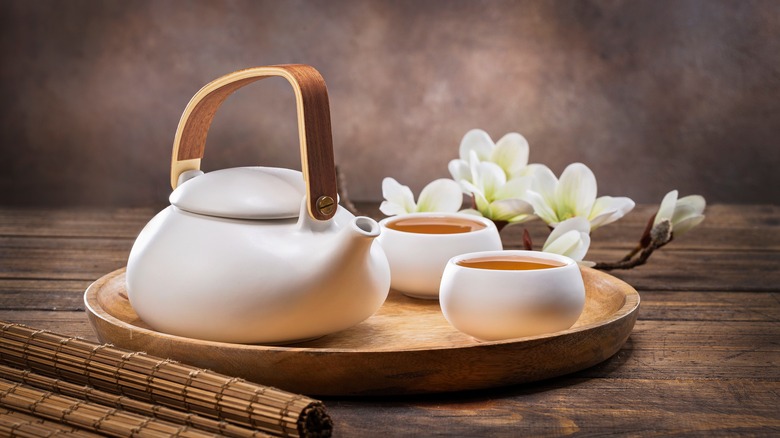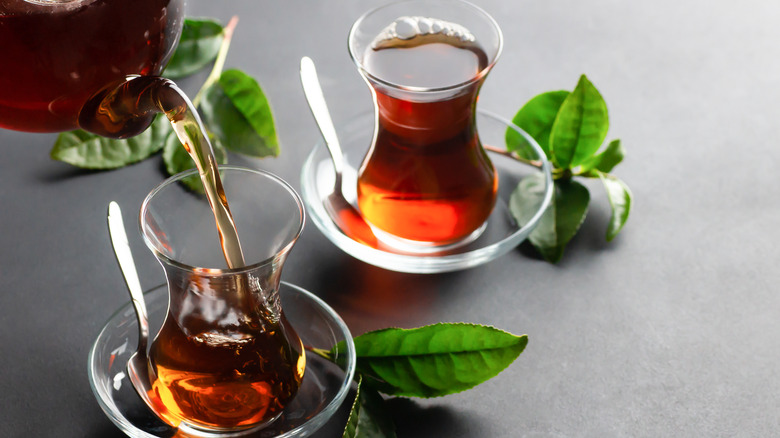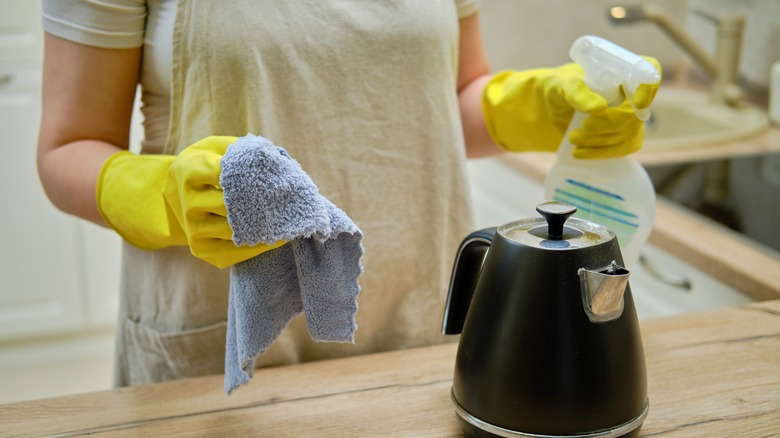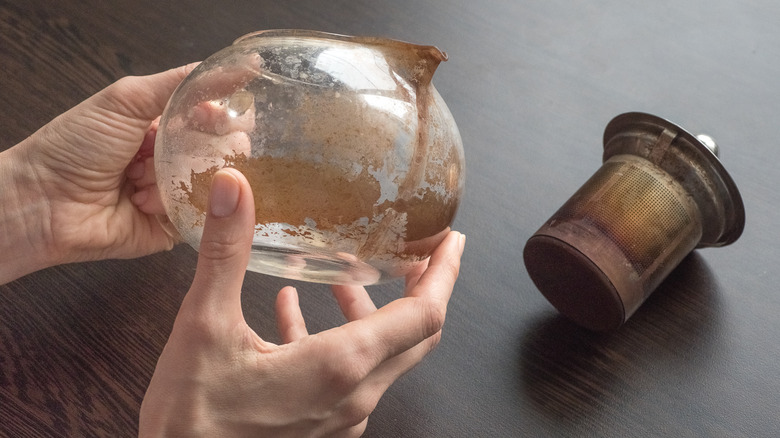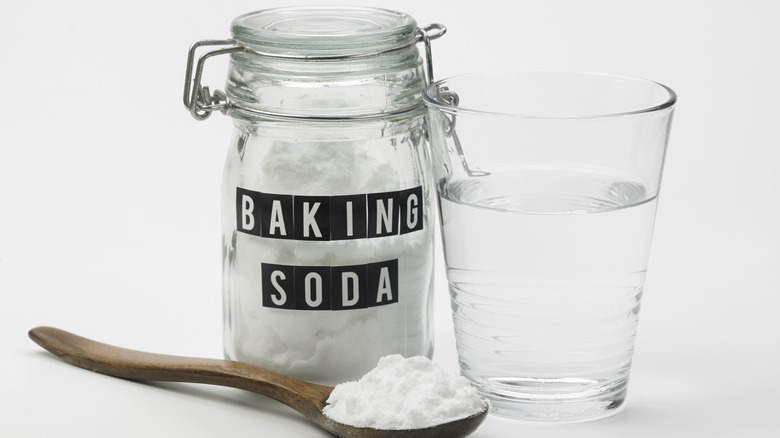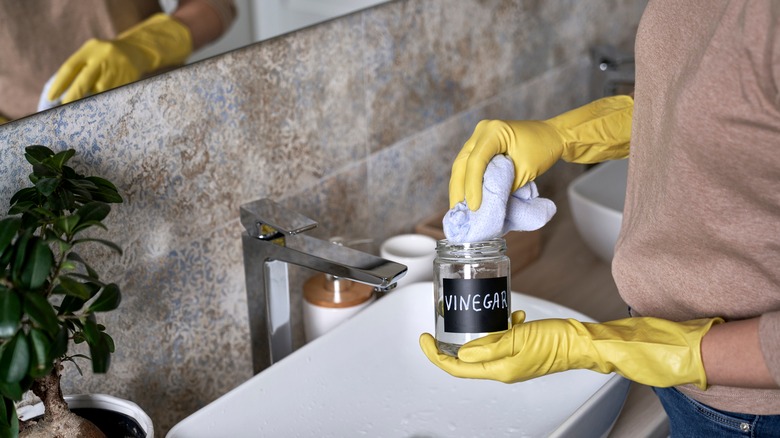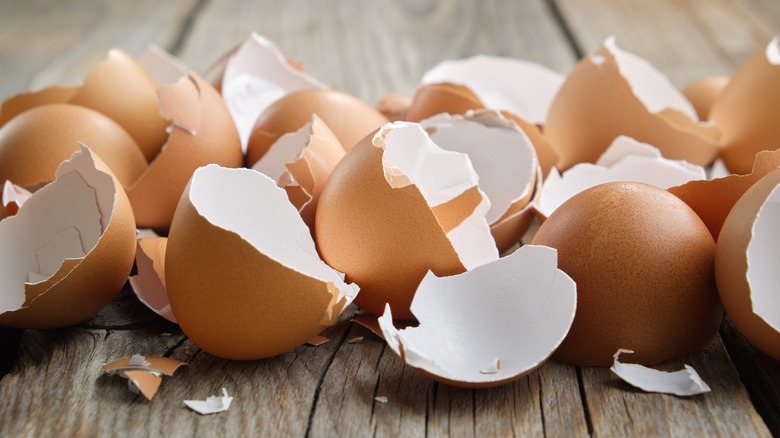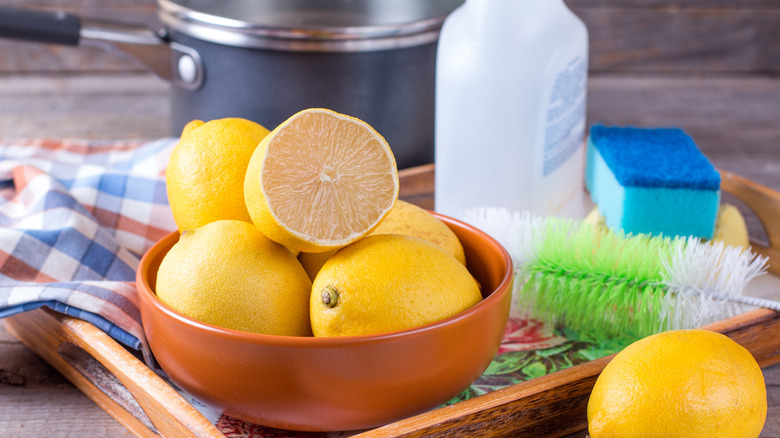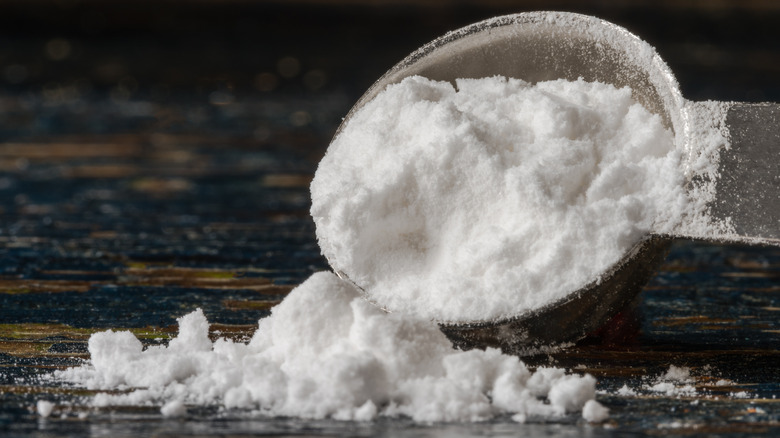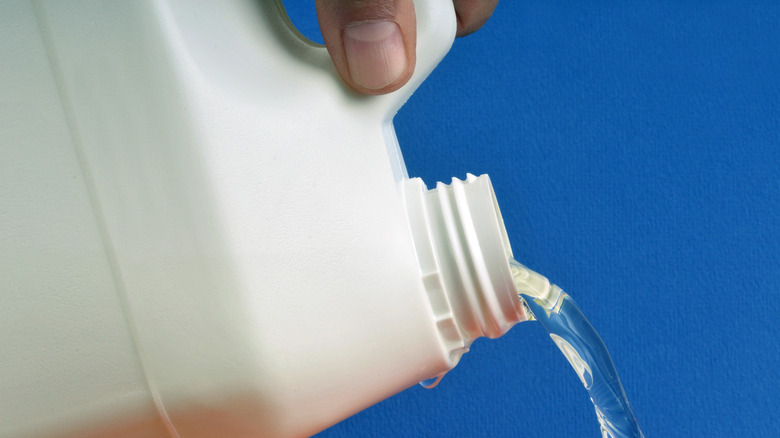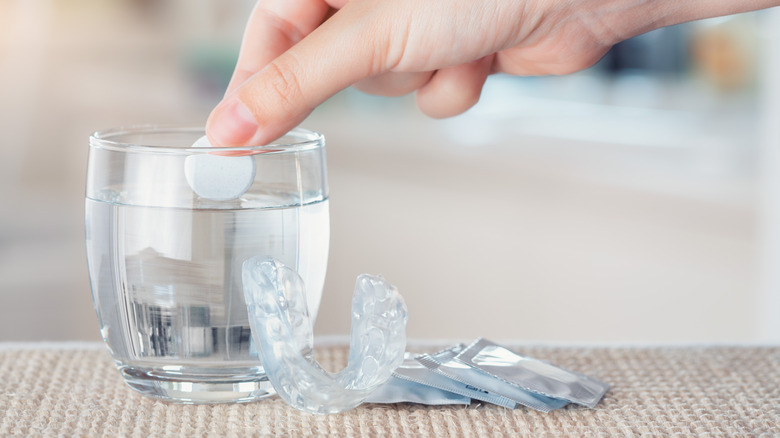How To Clean Tea Stains From A Teapot
You don't have to be the Queen of England or part of the British royal family to love tea time. This classic drink is a fun afternoon treat, a cozy beverage before bed, and offers great health benefits. Thanks to antioxidants known as flavonoids, tea is a true nutritional powerhouse. According to UC Health in Colorado, tea includes the flavonoid polyphenol, a powerful antioxidant. It helps remove free radicals, toxic compounds in the body that cause damage to our DNA.
Green tea contains the highest polyphenol levels and may promote heart health by decreasing oxidative cell damage. Jenifer Bowman, a UCHealth cardiac dietitian, told UC Health in Colorado, "Green tea is also higher in vitamin K compared to other varieties of tea. Some medications require low to moderate intake of vitamin K to avoid adverse interactions.' If green tea isn't your cup of tea, you can still receive great benefits from white and black teas, including cancer-fighting properties (white tea) and lower stroke risk (black tea). But how much should you drink to ensure you get all the benefits tea has to offer? There's no set amount, but two to three cups a day is a good rule of thumb (via Harvard T.H. Chan School of Public Health). If you're keeping an eye on your caffeine intake, give decaffeinated herbal teas a try.
Tea is a go-to drink all over the world
Drinking tea is a powerful health booster and an opportunity to slow down and introduce more mindfulness to your day. When brewing your cup, you'll join millions of other tea drinkers around the world in enjoying the beverage. According to Statista, tea is the second most-consumed drink in the world, behind water. Tea production globally is estimated to be around 6.1 million metric tons, with sales in the United States reaching over $13 billion in 2020 alone.
In 2021, 85 billion tea servings were enjoyed by Americans in the United States (via Tea Association of the USA Inc). That's the equivalent of 3.9 billion gallons! The most popular variety in America? Black tea accounts for 84 percent of United States tea consumption. Green tea was second, at 15 percent, followed by white, dark, and oolong tea varieties. Black tea is the most popular in England, often served from a teabag with milk and a few spoons of sugar. The sugar helps counteract the bitter flavor. Chai is an essential drink in India, with 837,000 tons consumed annually (via the BBC). The sweet beverage is made with spices, milk, and sugar and consumed at all times of the day. In China, considered the birthplace of tea, green tea accounts for ⅗ of the country's tea production.
Should you even bother cleaning that old teapot?
Cleaning your teapot is probably not the highest priority on your list of must-dos around the house. There are probably more important tasks, like cleaning your gutters or the kitchen floors. Or trying the #teapotchallenge on TikTok, right? However, when you find that your favorite vessel is looking a bit dingy on the inside after many brews and you start to research how to clean it, you may encounter a pervasive tea myth — that you rarely, if ever, need to clean a teapot.
Spoiler alert: You do! Thankfully, it's easy and doesn't take a lot of time, and it'll ensure that your tea drinks remain healthy and flavorful. According to Livestrong, not regularly cleaning the inside of a teapot can lead to a build-up of mineral deposits like limescale or calcium carbonate, particularly in areas with hard water. If you're in the United States, check out this handy map to see if you live in a hard water region (via U.S. Geological Survey). The build-up of minerals can affect the flavor of the teas you drink. Leaving stagnant water in a teapot can also result in bacteria growth.
If you're finding that your teapot or teacups still have stains after washing them with water and dish soap, many fast and easy cleaning alternatives will get them back to sparkling in minutes. All you'll need are a few simple items from around the house. Your teapot will be back to new with time to spare. Maybe you'll even have time to complete your own version of the #teapotchallenge.
Tea stains are definitely a thing, but easy to clean
Despite the many health and relaxation benefits of drinking tea, you've probably encountered at least one unfortunate side effect: tea stains in your teapot or teacups. The stains are a result of the powerful polyphenols within the tea. Tannins, a type of polyphenol, are what give teas their color but also cause the staining, per McGill University.
Tannins are found everywhere in nature (via Tannins). Most commonly, they're in tree bark, roots, fruits, seeds, and leaves, among other places. A kind of astringent, tannins are often recognizable by taste. If you've ever bitten into a not-yet-ripe apple or had an initially sharp first sip of red wine, that's the tannin taste.
The tannins in tea are on the acidic side, so removing them comes down to applying a substance containing a base to neutralize them. How that base neutralizes an acidic substance is a matter of chemistry. When an acid, like hydrochloric acid, for example, and a base, like sodium hydroxide, combine, a neutralization reaction occurs, and neutral products result — water and salt, which is a neutral compound (via K12 FlexBooks). Lucky for the millions and millions of tea drinkers out there, you don't need a degree in chemistry to enjoy tea or clean up after preparing it. You can easily remove tea stains using items you likely already have around your home.
Baking soda is a versatile cleaning agent
Do you notice tea stains inside your teapot? Are dish soap and water not working at getting them out? All you need to do is head back to your pantry for a quick, easy, and natural cleaning fix. Baking soda is a great, low-cost cleaning staple that most people already have at home. If not, pick up a box the next time you're at the store. It's super versatile and a practical product to have around the house.
Tea contains tannins, a type of polyphenol, that give the drink its color, but they can also cause staining of the vessel they're inside. McGill University reports that tannins are annoyingly resistant to scrubbing. A paste with baking soda and water will neutralize the acidic tannins and remove the stains. Apply the paste to the stains and let it sit for around 20 minutes. After wiping the paste off with a sponge, most (if not all) of the tea stains will have disappeared. Be sure to wash your teapot to remove the remaining paste. Baking soda has a pH level of nine, meaning it's a base substance (via U.S. Geological Survey). It's a great match against acidic substances like tannins since it dissolves organic matter. It's non-toxic, which means you can use it to clean places where you keep food and drinks.
Vinegar is a kitchen staple and cleaning powerhouse
Just like baking soda, vinegar is one of those multipurpose household staples that can deliver tons of benefits for little money. It has a pH of two, placing it high on the acidic side of the pH scale, according to the U.S. Geological Survey. The acidity in vinegar is powerful and capable of dissolving minerals, dirt, debris, and grease (via Healthline). Vinegar can also kill bacteria, making it a perfect low-cost and natural cleaning agent to get your teapot or teacups back to their sparkling state.
If you notice a build-up of minerals or deposits inside your tea vessel, try applying vinegar to remove them. You can use a spray bottle to apply the vinegar to hard water stains on surfaces (via Bob Hoegler Plumbing LLC). After applying the vinegar to the stains for about 15 minutes, use a bristled brush to scrub away what remains, and then wash your teapot normally. It's important to remember that the vinegar must not dry out. So if you notice any drying during the 15 minutes, spray more vinegar onto the surface. The type of vinegar you use doesn't matter. Whether you use plain old white vinegar or apple cider vinegar, either will tackle mineral deposits and build-up with naturally potent cleaning potential. When cleaning with vinegar, avoid electronic devices, wood surfaces, stone countertops, and washing machines.
Crushed eggshells are a natural scrubbing tool
With so many cleaning products available, it can be tricky to determine which ones will deliver the best results. It gets even more challenging when dealing with stubborn tea stains that won't wash out of your teapot with dish soap and water. Natural cleaning agents like baking soda and vinegar can be great tools for naturally removing tea stains. In cases where the staining is just not coming out, it's time to take another trip back to your kitchen. This time, reach for some eggs, specifically the shells. After you have several shells, crush them up with a coffee grinder, pestle and mortar, or put them in a plastic bag and roll over it with a rolling pin.
Crushed eggshells are excellent for scrubbing away tea stains. As reported by Mental Floss, eggshells, which are high in calcium, have a naturally abrasive texture, making them very effective as a scrubbing agent for pots and pans. The best way to get the right consistency for cleaning is to grind up the dried (and not-dyed) eggshells in a food processor. Combine the eggshells with baking soda (one tablespoon of eggshells and three tablespoons of baking soda) and a small amount of water for moisture. Then, use the mixture and scrub away those lingering tea stains in your teapot.
A simple alternative method is to drop the crushed eggshells into your teapot or teacup on top of the stains (via Spotless Living). After adding some water, let this sit overnight. Add some more water the next day, mix, and discard the eggshells in your compost. The stains should be gone and your teapot ready for simple washing like you usually do.
When life hands you lemons, use them to clean
The health benefits of lemons are as varied as they are plentiful. All parts of the cheerful citrus staple are good for you, even the rind. WebMD reports that lemons benefit everything from your heart to your immune system, digestion, and kidney functioning. Lemons, in particular, are a great source of fiber, iron, citric acid, and Vitamin C.
While a bowlful of lemons looks pretty on a table, these nutritional stars can also come in handy if you're trying to get rid of tea stains from a teapot or teacups. The natural antibacterial and antiseptic citric acid in lemon makes it a cleaning superstar. You can use citric acid and other natural acids when cleaning mineral or hard water deposits and rust stains (via New Mexico State University). This compound in lemons is useful against stains on metal surfaces, such as aluminum, brass, and copper.
To quickly and easily blast away hard water stains, mineral deposits, or tea stains from a kettle, use citric acid in its powder form, which is available at most grocery stores (via Syracuse.com). With your teapot half-full of water, bring it to boiling, and then add one to two tablespoons of citric acid to it once you've removed it from the stove. After about 15 to 20 minutes, rinse it out, wash thoroughly, and it'll be ready to go.
Cream of tartar will make tea stains go away
Tea stains clinging to your teapot? Your spice rack can fix that! The infrequently used but still gotta-have-it cream of tartar is a staple in baking as a leavener, but it's also great for removing tea stains that won't seem to budge. The fine powder can steady whipped egg whites in cakes, pastries, and meringues and stop sugar crystallization in its tracks for candies, per Simply Recipes. Cream of tartar, or potassium bitartrate as it's scientifically known, originates from wine (via Epicurious). It starts as tartaric acid, which naturally derives from grapes and gives the wine its tangy flavor. When wine ages, the tartaric acid combines with tannins, dead yeast cells, and other substances to form tartrates. This gunk became an essential element in baking soda in the 1850s. While most modern-day baking sodas don't feature cream of tartar anymore, it still offers a world of unique cleaning benefits for the home.
When any acid meets a base, that's where the chemistry pops up. Add cream of tartar to your teapot or glassware with coffee or tea stains (via Chemistry Cachet). Add hot water to this, and then scrub away the remnants of your tea before washing it regularly. Water is a neutral substance, but when combined with an acid, it will function as a base (via the University of Illinois Urbana-Champaign). The chemical reaction of the cream of tartar with water will enable you to get powerful cleaning results and a stain-free tea vessel.
A bit of bleach will work on tricky stains
Natural cleaning agents like vinegar, baking soda, and lemon juice are inexpensive and versatile home care tools to always keep on hand. Another low-cost cleaner you likely already have is bleach, which works well if you've got lingering tea stains in your beloved teapot or tea cups. Bleach works so well as a cleaner because it contains sodium hypochlorite, an oxidizer. When you apply bleach to a stain, oxidation occurs, and the oxidizer will take an electron (or multiple electrons) away from what it's reacting with. It changes the chemical structure of the staining compound. Scientific American notes that after applying bleach to a stain, it will disappear like magic. You can even take the color out of food coloring with the help of bleach.
There is also a scrub-free method for removing tea stains using bleach (via BRUU – The Gourmet Tea Club). All you have to do is fill your teapot with water and then add a drop of bleach to it. Leave this to sit overnight. The stains will dissolve by the morning. When using bleach in your teapot or tea cups, thoroughly wash the vessel at least once to ensure no traces of it are left over. Don't use this method for hand-painted pieces or teapots that are porous. Avoid using bleach on permeable surfaces like wood or drywall (via Healthline).
Denture tabs are a surprising tea-stain remover
From cookware to clogged drains to even a diamond ring or the toilet, denture tablets are a unique and surprisingly versatile cleaning tool not just for your teeth. Primarily used for cleaning and disinfecting removable dentures outside the mouth, they're also great for tackling tea stains in your teapot or teacups. You can clean everything from leather sofas and dirty shoes to tiles and retainers with denture tablets.
Most denture tabs contain sodium bicarbonate (or baking soda), a base substance, per Tiger Smile Family Dentistry. Applying a base like baking soda to stains left by an acidic substance, like tea, which gets its coloring from tannins, will help remove the staining (via McGill University). To try this easy method, drop a denture tab into your teapot, fill it with water, and then let it sit. Empty the teapot, and the staining should come off with some wiping. The tablets will fizz away the deposits and stains while cleaning any bacteria. Follow up with a thorough regular wash of your teapot and rinse with clean water. This method will also work on coffee stains in a coffee pot.
